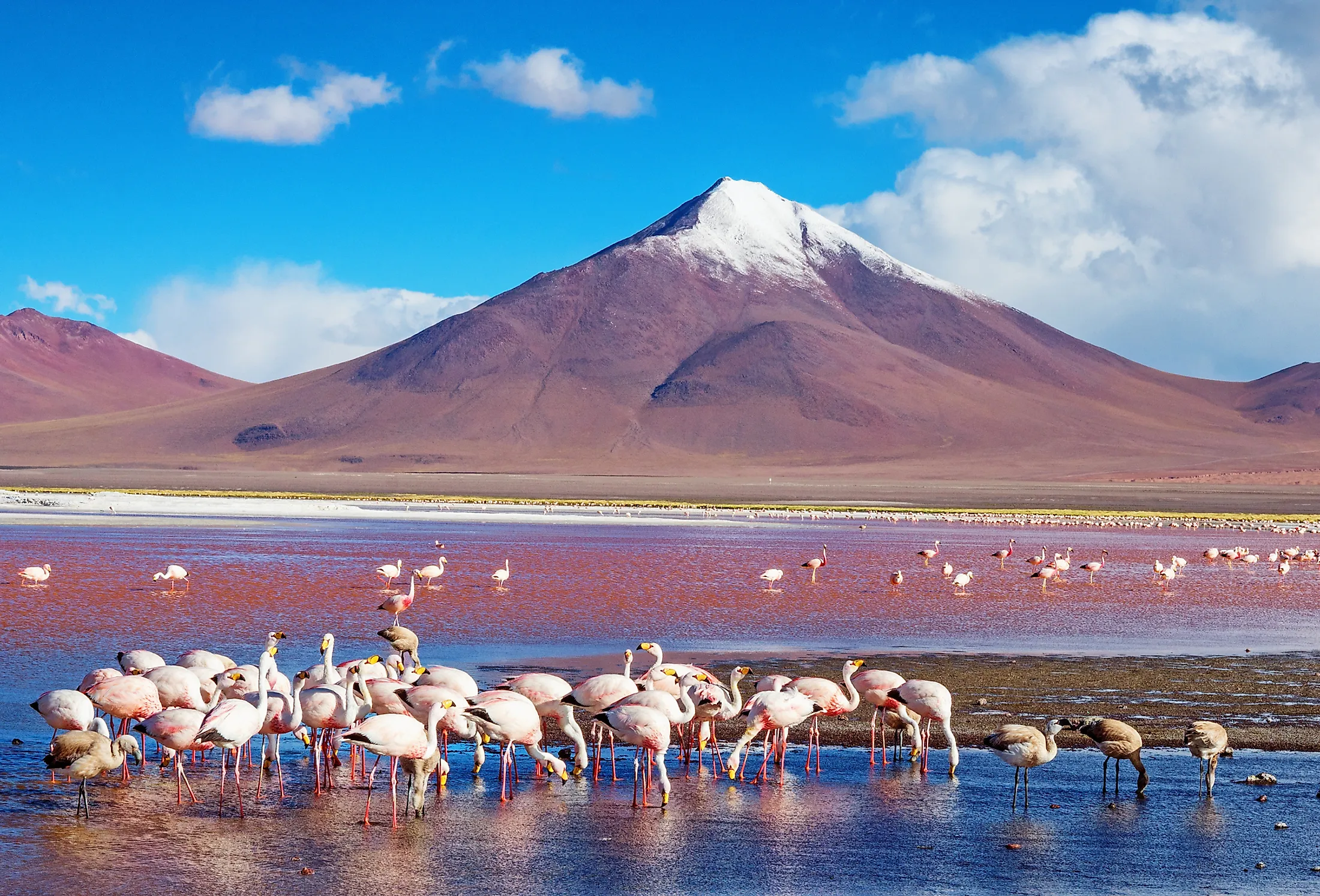In Bolivia, on the high plateaus, there are many lakes – salty and fresh. One of them is Laguna Colorado (Spanish: Laguna Colorado; ketch. Pukaqucha) – a shallow lake saturated with mineral salts, located on the vast Altiplano Plateau (Spanish: Altiplano), on the territory of the Eduardo Avaroa National Reserve (Spanish: Eduardo Avaroa Andean Fauna). National Reserve) in the southwestern part of Bolivia, near the border with Chile, at an altitude of 3.8 thousand meters above sea level.
Colorado Lagoon is surrounded by picturesque cliffs and boiling geysers. The magnificent landscapes here, stretching against the backdrop of the sparkling white Andean peaks, look like unearthly, as if you had miraculously found yourself on another planet.
Description and characteristics

Laguna Colorado is one of the important natural sites of international importance included in the Convention on Wetlands (1971). In 2007, the amazing mineral lake was among the nominees for the title of one of the seven New Wonders of Nature, but did not reach the final of the competition by the number of votes.
The lake refutes generally accepted ideas about the color of water: contrary to natural laws, the waters here are not habitually blue or green, but red-brown, which, along with the surrounding Martian landscapes and flocks of flamingos that have chosen these lands, gives the lagoon a unique and special flavor.
The unconventional color of the water, which, depending on the time of day and air temperature, acquires various shades of red (from pinkish to crimson), green and deep purple, is due to the pigmentation of seaweed and salt deposits present in it, as well as local sedimentary rocks. The combination of burgundy-terracotta water with snow-white islands of borax creates an amazing play of colors – an unforgettable fantastic spectacle.
Flora & Fauna in Laguna Colorado
The Red Lagoon, rich in plankton, is home to nearly 200 species of migratory birds. Despite the harsh local climate, the lake of rare beauty was chosen by numerous flamingos (about 40 thousand). In the Laguna-Colorado area, there are many representatives of a rare South American flamingo species – the pink flamingos of James (lat. Phoenicoparrus jamesi).
Despite the fact that there are very few of them left on the planet, beautiful birds accumulate in large numbers on the shore of the lake and are in this area invariably throughout the year, only periodically flying out of it.
Andean and Chilean flamingos can also be found here, although in much smaller numbers. Exotic birds roam the shallow water or stand picturesquely with their beaks submerged in the water.
Flamingos are especially beautiful at dawn, in the rays of the rising sun. The plumage of birds acquires a pink color due to plankton, which is present in abundance in the bottom layer of the lake, which they eat in large quantities. By the way, falling into captivity, pink flamingos very quickly become ordinary white birds. In order to fully enjoy the view of majestic flamingos in the morning, you can stay overnight in a small hotel located right on the lake.
Despite the harsh climatic conditions, vicunas, cougars, alpacas, llamas, foxes, chinchillas, and reptiles are found in the area.
At a distance of about 100 km from Krasnoe there is Green Lake, and between them lies a thermal zone consisting of hot springs, mud volcanoes and fumaroles – jets of hot volcanic gas and steam escaping from cracks. Of course, Green Lake is unusually inferior to Red Lake with its Martian landscapes, but this body of water is surrounded by a chain of smoking active volcanoes.
Nearby is also a small White Salt Lake (Spanish: Solar de Chalviri), along the banks of which there are many warm thermal springs where you can swim. The government of the country is trying to take action to use the geothermal energy of the earth, but so far the work has not progressed further than drilling wells.

In recent decades, more and more tourists have been rushing to Laguna Colorado, who are attracted here, first of all, by the unusual color scheme of fantastic, like alien landscapes.
Curious facts
The Colorado Lagoon with brown-red water is one of the most valuable “pearls” of Bolivia and the most visited place in the country.
Interestingly, the color of the lake changes depending on the weather and lighting. The water of the Lagoon can shimmer in various colors, from burgundy-black to greenish and yellowish.
On the shores of Laguna Colorado, a rather rare species of flamingo – the James Flamingo – lives in such numbers that it is rather difficult to believe in the rarity of these beautiful birds. In fact, this lake is one of the few places on the planet where the James Flamingos feel at home.
Back in the middle of the twentieth century, scientists were sure that the James Flamingo had completely disappeared in the world; only later it turned out that these rare birds still live in South America.
